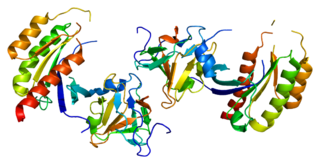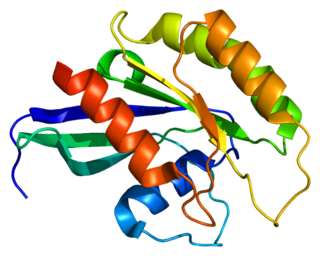Rab27 is a member of the Rab subfamily of GTPases. Rab27 is post translationally modified by the addition of two geranylgeranyl groups on the two C-terminal cysteines.

Unconventional myosin-Va is a motor protein in charge of the intracellular transport of vesicles, organelles and protein complexes along the actin filaments. In humans it is coded for by the MYO5A gene.

Filamin B, beta (FLNB), also known as Filamin B, beta , is a cytoplasmic protein which in humans is encoded by the FLNB gene.

Ras-related protein Rab-8A is a protein that in humans is encoded by the RAB8A gene.

Serine/threonine-protein kinase MRCK alpha is an enzyme that in humans is encoded by the CDC42BPA gene.

Myosin-2 is a protein that in humans is encoded by the MYH2 gene.

Synaptotagmin-like 2, also known as SYTL2, is a human gene.

Rabphilin-3A is a protein that in humans is encoded by the RPH3A gene. It contains two C2 domains and binds calcium ions at low micromolar concentration. Rabphilin was shown to regulate neurotransmitter release in hippocampal neurons after neurons had an increased synaptic activity and their release rate was depressed.

Myosin-Ic is a protein that in humans is encoded by the MYO1C gene.

Synaptotagmin-like protein 4 is a protein that in humans is encoded by the SYTL4 gene.

Regulating synaptic membrane exocytosis protein 2 is a protein that in humans is encoded by the RIMS2 gene.

Macrophage-capping protein (CAPG) also known as actin regulatory protein CAP-G is a protein that in humans is encoded by the CAPG gene.

Synaptotagmin-like protein 1 is a protein that in humans is encoded by the SYTL1 gene.

Ras-related protein Rab-40A is a protein that in humans is encoded by the RAB40A gene.

Myosin regulatory light chain interacting protein, also known as MYLIP, is a protein that in humans is encoded by the MYLIP gene.

Ras-related protein Rab-15 is a protein that in humans is encoded by the RAB15 gene.

Ras-related protein Rab-27A is a protein that in humans is encoded by the RAB27A gene.

Exophilin 5, also known as EXPH5, is a human gene.

Ras-related protein Rab-26 is a protein that in humans is encoded by the RAB26 gene.

Ras-related protein Rab-37 is a protein that in humans is encoded by the RAB37 gene.


















